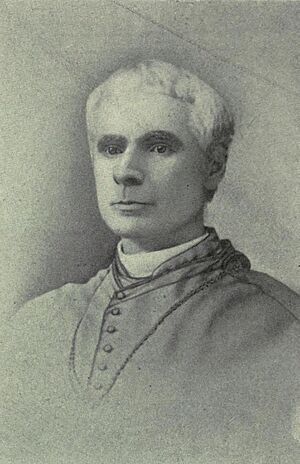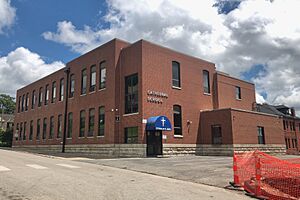Cathedral of St. Joseph (St. Joseph, Missouri) facts for kids
Quick facts for kids Cathedral of St. Joseph |
|
|---|---|

Cathedral of St. Joseph in 2024
|
|
| Location | 519 N. 10th St. St. Joseph, Missouri |
| Country | United States |
| Denomination | Roman Catholic Church |
| History | |
| Status | Co-cathedral/Parish |
| Founded | 1845 (parish) |
| Dedication | Saint Joseph |
| Architecture | |
| Functional status | Active |
| Architect(s) | Patrick F. Meagher |
| Style | Romanesque Revival |
| Groundbreaking | 1869 |
| Completed | 1871 |
| Specifications | |
| Materials | Brick |
| Administration | |
| Archdiocese | Kansas City–St. Joseph |
The Cathedral of St. Joseph is an important Catholic cathedral located in St. Joseph, Missouri, United States. It serves as one of the main churches for the Diocese of Kansas City-St. Joseph, sharing this role with the Cathedral of the Immaculate Conception in Kansas City, Missouri. The cathedral building, along with its rectory (where priests live) and convent (where nuns live), are part of a special historical area called the Cathedral Hill Historic District. These buildings are recognized on the National Register of Historic Places because of their historical importance.
Contents
Exploring the History of St. Joseph Cathedral
How the Church Began in St. Joseph
The city of St. Joseph, Missouri, was first settled by Joseph Robidoux in 1826. The first priest to visit this area was Father Pierre-Jean De Smet, a Jesuit missionary, in 1838. He met with Robidoux and wanted to build a chapel there.
The very first Mass (a Catholic church service) in the settlement happened in Robidoux's log house that same year. Jesuit priests continued to visit the area regularly between 1838 and 1845. Robidoux officially planned and named the town of St. Joseph in 1843.
In 1845, Father Thomas Scanlan arrived in St. Joseph. He quickly started plans to build a church. A brick church, about 40 by 20 feet (12 by 6 meters), was built. It was located at the corner of Fifth and Felix Streets. Archbishop Peter Richard Kenrick from St. Louis dedicated this church on June 17, 1847. It was named St. Joseph's Church. At that time, the church served about 20 families. Father Scanlan passed away in 1860. He was replaced by Father John Hennessy, who led the parish until 1893.
Building the Cathedral of St. Joseph
On March 3, 1868, Pope Pius IX created the Diocese of St. Joseph. This meant that St. Joseph's Church became the main church, or cathedral, for the new diocese. Bishop John J. Hogan bought land at Tenth and Isadore Streets to build the current cathedral.
The first stone for the new cathedral was laid on September 12, 1869. Building the cathedral took a long time because there wasn't always enough money. This was partly due to a financial crisis in 1873. To help raise money, some important church members organized a raffle. They offered 60 pieces of land in the cathedral's neighborhood as prizes. Tickets for the raffle cost $3 each.
Ticket sales were slower than expected, so the drawing was delayed. The first Mass was held in the new cathedral on March 17, 1871. However, the inside walls were not yet plastered, and the beautiful stained glass windows were not installed. Construction continued until 1883. The old church building was eventually taken down, and the land was sold. The money from that sale helped pay for the new cathedral.
Father Ignatius Conrad, a Benedictine priest, became the Rector (the priest in charge) in 1876. He served the parish until 1892. The rectory, where the priests live, was built in 1893. Before this, the parish priest lived in an apartment inside the church. The rectory also served as the main office for the diocese.
Bishop Maurice F. Burke oversaw a major update of the cathedral in 1900. During this time, the two towers and a front entrance porch were finally built, following the original plans.
In 1924, Father Leo Ruggle joined the cathedral as an associate pastor. He held important roles in the diocese and served as Rector from 1937 to 1964. He was a beloved figure, and the renovated church basement was named in his honor before he passed away in 1984.
On August 29, 1956, Pope Pius XII combined the Diocese of St. Joseph with the Diocese of Kansas City. This created the new Diocese of Kansas City-St. Joseph. The Cathedral of St. Joseph now shares its role as the main church with the Cathedral of the Immaculate Conception in Kansas City.
The Cathedral of St. Joseph was updated again from 1969 to 1970. These changes followed new guidelines from the Second Vatican Council, which aimed to modernize Catholic worship. More renovations happened in 1981 and 1995. In the 1980s, the church also opened a food pantry to help people in need.
Catholic Schools and Community
In the 1850s, different religious groups came to St. Joseph to open schools. The Religious of the Sacred Heart and the Christian Brothers started schools. Later, the Daughters of Charity of St. Vincent de Paul arrived in 1869. They began running a school and a hospital. They operated St. Joseph's Hospital for many years, from 1891 to the 1980s.
The Religious of the Sacred Heart opened St. Joseph's first parish school in 1901. In 1920, the Benedictine Sisters took over teaching at the school. Christian Brothers High School, which is now Bode Middle School, was built during the time of Bishop Francis Gilfillan.
The school building was updated in 1954. A new gymnasium and auditorium were built in 1958, named after Msgr. Charles Nowland. A pre-school program was added in 1981. By the late 1980s, all the teachers at the school were lay people (not priests or nuns). The old convent building was turned into a day care center. Today, it is known as the Cathedral Early Childhood Center.
Cathedral Architecture and Design
The Cathedral of St. Joseph is built from brick and designed in the Romanesque Revival style. This style often uses round arches and strong, solid shapes. The architect who designed it was Patrick F. Meagher. He also designed the Buchanan County Courthouse later on.
The church building has a transept (a part that crosses the main body of the church) and two towers at the front. These towers have pointed, pyramid-shaped roofs. The main roof of the church was originally covered with special Spanish tiles, but these were later replaced. A front entrance area, called the narthex, with three doors, was added in 1956.
The rectory, where the priests live, is a three-story brick building. It has interesting features like projecting bay windows. The porch of the rectory is shaped like an "L" and is supported by columns in the Romanesque style. The auditorium building, built in the 1950s, has some Art Deco design elements.
The convent building, where the nuns used to live, is influenced by the Colonial Revival style. It has a sloped roof and a front porch with classic Doric columns. The school building looks similar to the convent. It is a two-story brick building. It used to have a third floor, but that part has since been removed.
Past Leaders of the Cathedral
Here are the priests who have served as pastors of St. Joseph's parish and later as the cathedral's rector:
- Rev. Thomas Scanlan (1845–1860)
- Rev. John Hennessy (1860–1866)
- Rev. James Doherty (1866–1868)
- Bishop John J. Hogan (1868–1876)
- Rev. Ignatius Conrad, O.S.B. (1876–1892)
- Rev. Andrew Newman (1892–1893)
- Bishop M. F. Burke (1893–1913)
- Rev. John J. O’Neill (1913–1923)
- Rev. Maurice F. Connor (1923–1926)
- Rev. Charles F. Buddy (1926–1937)
- Msgr. Leo J. Ruggle (1937–1964)
- Msgr. Charles S. Nowland (1964–1973)
- Msgr. Robert J. Hogan (1973–1979)
- Rev. Gerald R. Waris (1979–1986)
- Rev. Patrick Tobin (1986–1988)
- Rev. Thomas J. D. Hawkins (1988–1995)
- Rev. Wayne L. Walter (1995–1996)
- Msgr. Richard M. Dierkes (1996–2008)
- Rev. Joseph B. Powers (2008–2012)
- Rev. Matthew Rotert (2012–2018)
- Rev. Stephen Hansen (2018–Present)
See also
 In Spanish: Catedral de San José (St. Joseph) para niños
In Spanish: Catedral de San José (St. Joseph) para niños






